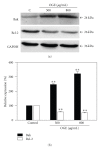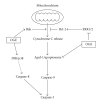Ocimum gratissimum Aqueous Extract Induces Apoptotic Signalling in Lung Adenocarcinoma Cell A549
- PMID: 20953389
- PMCID: PMC2952322
- DOI: 10.1155/2011/739093
Ocimum gratissimum Aqueous Extract Induces Apoptotic Signalling in Lung Adenocarcinoma Cell A549
Abstract
Ocimum gratissimum (OG) is widely used as a traditional herb for its antibacterial activity in Taiwan. Recently, antitumor effect of OG on breast cancer cell is also reported; however, the effects of OG on human pulmonary adenocarcinoma cell A549 remain unclear. Therefore, we aimed to investigate whether aqueous OG extract (OGE) affects viability of A549 cells and the signals induced by OGE in A549 cells. Cell viability assays revealed that OGE significantly and dose-dependently decreased the viability of A549 cell but not that of BEAS-2B cell. Morphological examination and DAPI staining indicated that OGE induced cell shrinkage and DNA condensation for A549 cells. Further investigation showed that OGE enhanced activation of caspase-3, caspase-9 and caspase-8 and increased protein level of Apaf-1 and Bak, but diminished the level of Bcl-2. Additionally, OGE inhibited the phosphorylation of extracellular signal-regulated kinase (ERK) yet enhanced the phosphorylation of c-Jun N-terminal kinase (JNK) and p38 MAP kinase (p38). In conclusion, our findings indicate that OGE suppressed the cell viability of A549 cells, which may result from the activation of apoptotic signaling and the inhibition of anti-apoptotic signaling, suggesting that OGE might be beneficial to lung carcinoma treatment.
Figures







Similar articles
-
Ocimum gratissimum Aqueous Extract Protects H9c2 Myocardiac Cells from H(2)O(2)-Induced Cell Apoptosis through Akt Signalling.Evid Based Complement Alternat Med. 2011;2011:578060. doi: 10.1155/2011/578060. Epub 2010 Aug 30. Evid Based Complement Alternat Med. 2011. PMID: 20953436 Free PMC article.
-
Novel target genes responsive to apoptotic activity by Ocimum gratissimum in human osteosarcoma cells.Am J Chin Med. 2014;42(3):743-67. doi: 10.1142/S0192415X14500487. Am J Chin Med. 2014. PMID: 24871663
-
Ethanolic extract Ocimum sanctum Linn. induces an apoptosis in human lung adenocarcinoma (A549) cells.Heliyon. 2019 Nov 14;5(11):e02772. doi: 10.1016/j.heliyon.2019.e02772. eCollection 2019 Nov. Heliyon. 2019. PMID: 31844708 Free PMC article.
-
Aqueous Ocimum gratissimum extract induces cell apoptosis in human hepatocellular carcinoma cells.Int J Med Sci. 2020 Jan 18;17(3):338-346. doi: 10.7150/ijms.39436. eCollection 2020. Int J Med Sci. 2020. PMID: 32132869 Free PMC article.
-
Aqueous Extracts of Ocimum gratissimum Sensitize Hepatocellular Carcinoma Cells to Cisplatin through BRCA1 Inhibition.Int J Mol Sci. 2024 Aug 1;25(15):8424. doi: 10.3390/ijms25158424. Int J Mol Sci. 2024. PMID: 39125994 Free PMC article.
Cited by
-
Protective Effects of Ocimum gratissimumAqueous Extracts on HaCaT Cells Against UVC-Induced Inhibition of Cell Viability and Migration.Int J Med Sci. 2021 Mar 12;18(9):2086-2092. doi: 10.7150/ijms.54644. eCollection 2021. Int J Med Sci. 2021. PMID: 33850479 Free PMC article.
-
Promising leads against lung cancer from the plants in Lamiaceae family.Bioimpacts. 2024 Jun 8;15:30074. doi: 10.34172/bi.30074. eCollection 2025. Bioimpacts. 2024. PMID: 39963559 Free PMC article. Review.
-
Anti-apoptotic and antioxidant mechanisms may underlie the abrogative potential of Ocimum gratissimum Linn. Leaf extract and fractions against trastuzumab-induced cardiotoxicity in Wistar rats.Toxicol Rep. 2024 Jan 18;12:200-214. doi: 10.1016/j.toxrep.2024.01.011. eCollection 2024 Jun. Toxicol Rep. 2024. PMID: 38313815 Free PMC article.
-
Aqueous extracts of Ocimum grasstimum inhibits lipopolysaccharide-induced interleukin-6 and interleukin-8 expression in airway epithelial cell BEAS-2B.Chin J Integr Med. 2013 Oct;19(10):741-8. doi: 10.1007/s11655-012-1251-3. Epub 2012 Dec 3. Chin J Integr Med. 2013. PMID: 23212574
-
Ocimum gratissimum retards breast cancer growth and progression and is a natural inhibitor of matrix metalloproteases.Cancer Biol Ther. 2013 May;14(5):417-27. doi: 10.4161/cbt.23762. Epub 2013 Feb 4. Cancer Biol Ther. 2013. PMID: 23380593 Free PMC article.
References
-
- Jemal A, Siegel R, Ward E, et al. Cancer statistics, 2006. Ca: A Cancer Journal for Clinicians. 2006;56(2):106–130. - PubMed
-
- Parkin DM. Global cancer statistics in the year 2000. Lancet Oncology. 2001;2(9):533–543. - PubMed
-
- Zhu W, Wang X-M, Zhang L, Li X-Y, Wang B-X. Pharmacokinetic of Rhein in healthy male volunteers following oral and retention enema administration of rhubarb extract: a single dose study. American Journal of Chinese Medicine. 2005;33(6):839–850. - PubMed
-
- Willett WC. Diet and health: what should we eat? Science. 1994;264(5158):532–537. - PubMed
-
- Fontham ETH. Protective dietary factors and lung cancer. International Journal of Epidemiology. 1990;19(1):S32–S42. - PubMed
LinkOut - more resources
Full Text Sources
Research Materials
Miscellaneous

